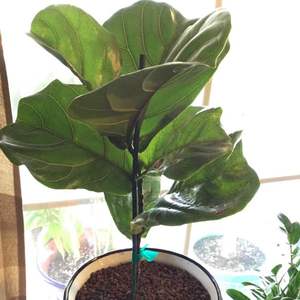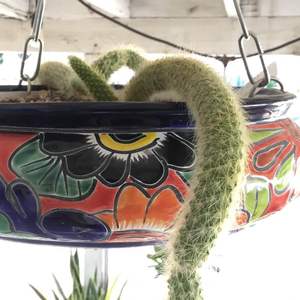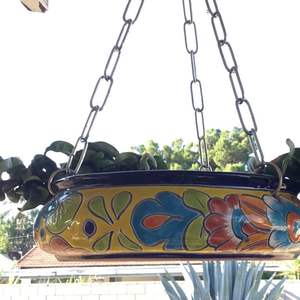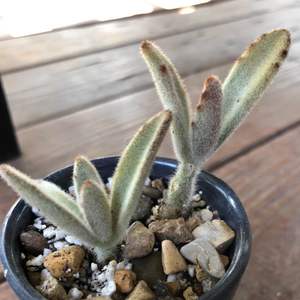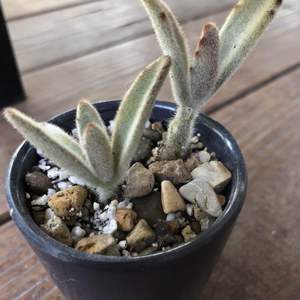文章
Miss Chen
2018年08月05日

Hailing from Tanzania in East Africa, the aptly-named African violet (Saintpaulia spp.) has been grown a houseplant for generations, although it potentially grows outdoors in U.S. Department of Agriculture plant hardiness zone 11. This dainty-looking beauty has deep green, symmetrical leaves and colorful flowers that bloom nearly year-round on healthy plants. An African violet may attract many sucking insect pests, including aphids, which can affect its health. Get rid of these pests to keep your plant blooming and looking its best.

Use Nonchemical Control Methods
Washing aphids off African violets is one of the simplest ways to kill aphids, although the plant's leaves may end up with spots. Make a soap solution by mixing 2 teaspoons mild liquid dish soap into 1 gallon of warm water. Use a soft cloth or soft-bristle brush to gently wash the tops and undersides of leaves. Wash your plant whenever aphids reappear. Don't use dishwasher or laundry detergent because they may damage the African violet's leaves. Pinching off infested leaves can help control small aphid populations. Placing the African violet in a sink or tub and hosing it down with a strong stream of water rinses the pests off your plant and down the drain. Or, if you only have a few aphids, dip a cotton ball in isopropyl alcohol and wipe the bugs off the plant.
Spray Houseplants Indoors
Insecticidal soaps kill off aphids and are safe to use inside your home. Carefully read and follow your specific product's instructions and safety precautions because directions will vary. A ready-to-use formula simplifies things. Spray to thoroughly cover the leaves and stems, including the undersides of leaves. To work, the spray needs to smother the aphids. Repeat treatment every four to seven days until you spot no more aphids on your African violet. Insecticidal soaps sometimes burn plant leaves, so test the solution on a small section of an inconspicuous leaf and check for damage about 48 hours later. Treat your entire plant if the test spot wasn't damaged. If you're worried, rinse the African violet two hours after treatment to remove the insecticidal soap residue.
Treat Plants Outdoors
If you live in a warm enough climate to grow African violets outdoors, or if the weather is warm enough to bring houseplants outside, Upper Pinellas African Violet Society recommends treating plants with a malathion solution containing 2 teaspoons of product, 1 gallon of water and several drops of mild dish soap. Use a small hand sprayer or spray bottle to completely cover the foliage, including the tops and undersides of leaves. Spray African violets every seven to 10 days until the aphids are gone. Let the spray dry completely before you bring the plant back inside. Malathion is toxic to honeybees, so spray your African violets in the early morning or around dusk when bees aren't actively pollinating.
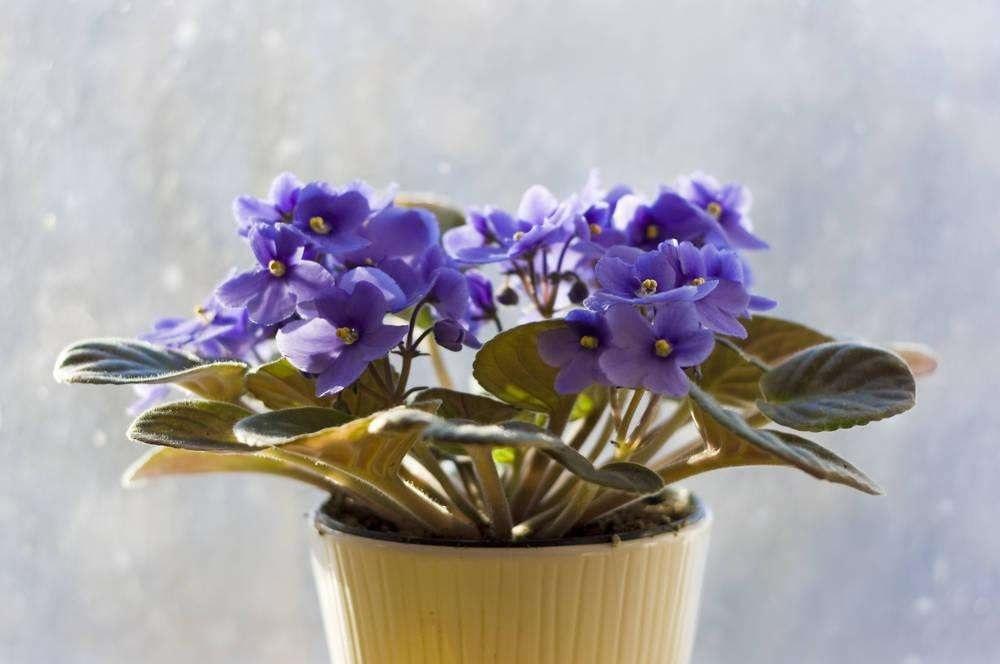
Safety First
Insecticidal soap solutions and chemical pesticides can cause skin and eye irritation on contact. Protect yourself from exposure by wearing long sleeves, pants, shoes with socks, waterproof gloves, goggles and a face mask. Early pest detection and control is crucial to keep aphids from injuring an African violet. If possible, isolate any new plants for two to three weeks before placing them among your established houseplants.

Use Nonchemical Control Methods
Washing aphids off African violets is one of the simplest ways to kill aphids, although the plant's leaves may end up with spots. Make a soap solution by mixing 2 teaspoons mild liquid dish soap into 1 gallon of warm water. Use a soft cloth or soft-bristle brush to gently wash the tops and undersides of leaves. Wash your plant whenever aphids reappear. Don't use dishwasher or laundry detergent because they may damage the African violet's leaves. Pinching off infested leaves can help control small aphid populations. Placing the African violet in a sink or tub and hosing it down with a strong stream of water rinses the pests off your plant and down the drain. Or, if you only have a few aphids, dip a cotton ball in isopropyl alcohol and wipe the bugs off the plant.
Spray Houseplants Indoors
Insecticidal soaps kill off aphids and are safe to use inside your home. Carefully read and follow your specific product's instructions and safety precautions because directions will vary. A ready-to-use formula simplifies things. Spray to thoroughly cover the leaves and stems, including the undersides of leaves. To work, the spray needs to smother the aphids. Repeat treatment every four to seven days until you spot no more aphids on your African violet. Insecticidal soaps sometimes burn plant leaves, so test the solution on a small section of an inconspicuous leaf and check for damage about 48 hours later. Treat your entire plant if the test spot wasn't damaged. If you're worried, rinse the African violet two hours after treatment to remove the insecticidal soap residue.
Treat Plants Outdoors
If you live in a warm enough climate to grow African violets outdoors, or if the weather is warm enough to bring houseplants outside, Upper Pinellas African Violet Society recommends treating plants with a malathion solution containing 2 teaspoons of product, 1 gallon of water and several drops of mild dish soap. Use a small hand sprayer or spray bottle to completely cover the foliage, including the tops and undersides of leaves. Spray African violets every seven to 10 days until the aphids are gone. Let the spray dry completely before you bring the plant back inside. Malathion is toxic to honeybees, so spray your African violets in the early morning or around dusk when bees aren't actively pollinating.

Safety First
Insecticidal soap solutions and chemical pesticides can cause skin and eye irritation on contact. Protect yourself from exposure by wearing long sleeves, pants, shoes with socks, waterproof gloves, goggles and a face mask. Early pest detection and control is crucial to keep aphids from injuring an African violet. If possible, isolate any new plants for two to three weeks before placing them among your established houseplants.
0
0
成长记
kensong
2018年08月04日

They are so prolific that it'll root off the stem of the mother plant if there's no room.


1
0
文章
Miss Chen
2018年08月03日

Description: This plant is a summer annual about 3-5' tall. It often branches toward the base of the plant, while the upper stems remain unbranched. These stems are light green and covered with long glandular hairs. The lower to middle leaves are palmately compound with 3-7 leaflets, while the upper leaves are simple. These leaves are alternate and become smaller in size as they ascend the stems. The compound leaves span up to 6-8" across; the lower compound leaves have long stout petioles, while the upper compound leaves have short stout petioles or they are sessile. These petioles are light green and covered with glandular hairs. At the base of each petiole, there is a pair of small spiny stipules. The leaflets of the compound leaves are narrowly ovate, oblanceolate, or lanceolate in shape, and their margins are smooth or serrated. Both sides of these leaflets are covered with short glandular hairs; their upper surfaces are medium to dark green. The simple leaves are broadly lanceolate to cordate-ovate, sessile to clasping along each upper stem, and smaller in size than the compound leaves; otherwise they have similar characteristics. The glandular hairs of the foliage provide the plant with a fetid scent.
The upper stems terminate in large racemes of flowers. These flowers are crowded together toward the apex of each raceme, while scattered seedpods develop below. Each flower spans about 1–1½" across (excluding the stamens), consisting of 4 white to pink petals, 4 light green sepals, 6 long-exerted stamens, and a pistil with a short style. The erect to ascending petals are oblanceolate with well-rounded margins, becoming linear (or clawed) near the base of the flower. The stamens have long slender filaments about 2-3" long. The sepals are linear-lanceolate and much smaller than the petals; they bend away from the base of the flower with age. Each flower has an ascending pedicel. The blooming period occurs from mid-summer to early fall and lasts 1½–3 months. Each flower is replaced by a cylindrical seedpod on a long narrow stipe. Both the seedpod and the stipe are glabrous. Each seedpod contains several seeds. The root system consists of a taproot. This plant spreads by reseeding itself.
Cultivation: Spider Flower adapts to full or partial sun, moist to slightly dry conditions, and different kinds of soil, including those containing loam, clay-loam, or gravel. It requires warm weather and a long growing season to fully develop from seed.
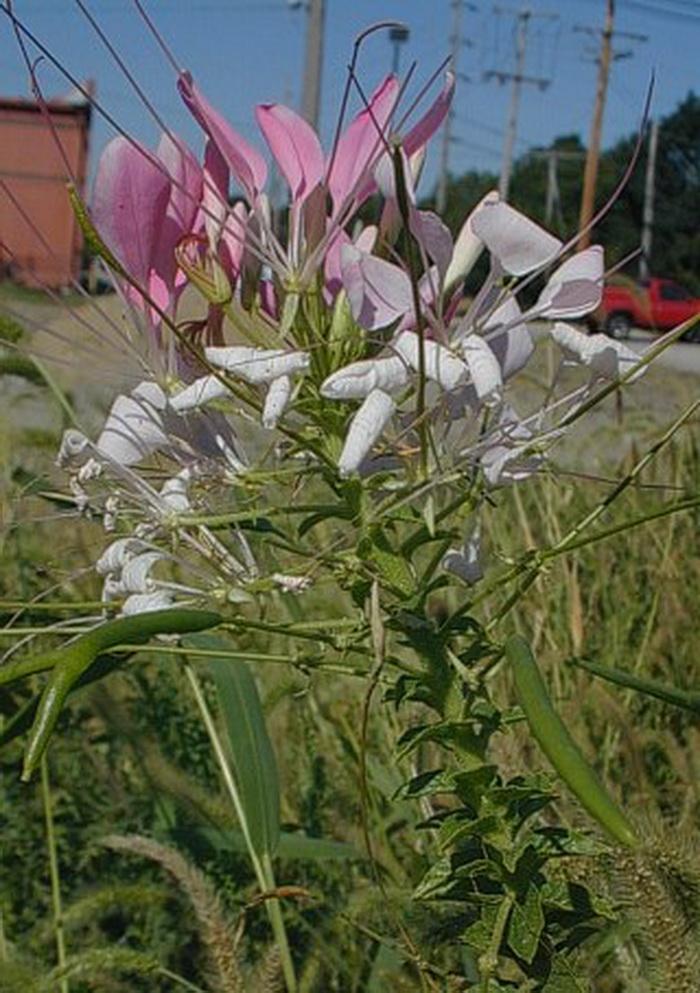
Range & Habitat: Spider Flower has naturalized in Illinois in widely scattered areas (see Distribution Map). Aside from its cultivation in gardens, this species is uncommon and rarely persists. It was introduced into North America from tropical South America as an ornamental plant. Habitats include vacant lots, edges of yards, gravelly shores along rivers, and miscellaneous waste areas. It is usually found in habitats with a history of disturbance.
Faunal Associations: In its native tropical habitat, the pollinators of the flowers are primarily bats (Machado et al., 2006), which seek nectar. Sphingid moths also visit the flowers, but they are regarded as nectar thieves. In Illinois and other temperate areas, the pollinators of the flowers are currently unknown. Various beetles appear to be attracted to the flowers, and flies or small bees probably seek nectar or pollen from them. However, the mouthparts and body size of these insects are too small to function as effective pollinators. Other insects that are attracted to Spider Flower and other Cleome spp. include Phyllotreta cruciferae (Crucifer Flea Beetle) and Phyllotreta striolata (Striped Flea Beetle), which chew small holes in the leaves. On rare occasions, the caterpillars of Pieris rapae (Cabbage Butterfly) have been observed to feed on the foliage. According to some observations in western United States, the Ring-Necked Pheasant and Mourning Dove eat the seeds of Cleome spp. to a limited extent. The fetid foliage is rejected by cattle when there is more palatable food available.
Photographic Location: A vacant lot in Urbana, Illinois, where a few plants were growing wild.

Comments: The showy flowers have an odd structure and appearance, although this is not unusual for Cleome spp. (Bee Plants, etc.) and the related Polanisia spp. (Clammyweed). Among the species in this group that naturalize in Illinois, Spider Flower has showier flowers than most and the filaments of its stamens are exceptionally long (2-3" in length). It is also larger in size than these other species (up to 5' tall). The closely related Cleome serrulata (Rocky Mountain Bee Plant) is occasionally adventive from the Western states. It has compound leaves with only 3 leaflets, while the compound leaves of Spider Flower usually have 5-7 leaflets. Species of Clammyweed are distinguished from Cleome spp. primarily by their seedpods, which lack stipes (a beak-like structure in front of the seedpod). An older scientific name for Spider Flower is Cleome spinosa, which refers to the spiny stipules.
The upper stems terminate in large racemes of flowers. These flowers are crowded together toward the apex of each raceme, while scattered seedpods develop below. Each flower spans about 1–1½" across (excluding the stamens), consisting of 4 white to pink petals, 4 light green sepals, 6 long-exerted stamens, and a pistil with a short style. The erect to ascending petals are oblanceolate with well-rounded margins, becoming linear (or clawed) near the base of the flower. The stamens have long slender filaments about 2-3" long. The sepals are linear-lanceolate and much smaller than the petals; they bend away from the base of the flower with age. Each flower has an ascending pedicel. The blooming period occurs from mid-summer to early fall and lasts 1½–3 months. Each flower is replaced by a cylindrical seedpod on a long narrow stipe. Both the seedpod and the stipe are glabrous. Each seedpod contains several seeds. The root system consists of a taproot. This plant spreads by reseeding itself.
Cultivation: Spider Flower adapts to full or partial sun, moist to slightly dry conditions, and different kinds of soil, including those containing loam, clay-loam, or gravel. It requires warm weather and a long growing season to fully develop from seed.

Range & Habitat: Spider Flower has naturalized in Illinois in widely scattered areas (see Distribution Map). Aside from its cultivation in gardens, this species is uncommon and rarely persists. It was introduced into North America from tropical South America as an ornamental plant. Habitats include vacant lots, edges of yards, gravelly shores along rivers, and miscellaneous waste areas. It is usually found in habitats with a history of disturbance.
Faunal Associations: In its native tropical habitat, the pollinators of the flowers are primarily bats (Machado et al., 2006), which seek nectar. Sphingid moths also visit the flowers, but they are regarded as nectar thieves. In Illinois and other temperate areas, the pollinators of the flowers are currently unknown. Various beetles appear to be attracted to the flowers, and flies or small bees probably seek nectar or pollen from them. However, the mouthparts and body size of these insects are too small to function as effective pollinators. Other insects that are attracted to Spider Flower and other Cleome spp. include Phyllotreta cruciferae (Crucifer Flea Beetle) and Phyllotreta striolata (Striped Flea Beetle), which chew small holes in the leaves. On rare occasions, the caterpillars of Pieris rapae (Cabbage Butterfly) have been observed to feed on the foliage. According to some observations in western United States, the Ring-Necked Pheasant and Mourning Dove eat the seeds of Cleome spp. to a limited extent. The fetid foliage is rejected by cattle when there is more palatable food available.
Photographic Location: A vacant lot in Urbana, Illinois, where a few plants were growing wild.

Comments: The showy flowers have an odd structure and appearance, although this is not unusual for Cleome spp. (Bee Plants, etc.) and the related Polanisia spp. (Clammyweed). Among the species in this group that naturalize in Illinois, Spider Flower has showier flowers than most and the filaments of its stamens are exceptionally long (2-3" in length). It is also larger in size than these other species (up to 5' tall). The closely related Cleome serrulata (Rocky Mountain Bee Plant) is occasionally adventive from the Western states. It has compound leaves with only 3 leaflets, while the compound leaves of Spider Flower usually have 5-7 leaflets. Species of Clammyweed are distinguished from Cleome spp. primarily by their seedpods, which lack stipes (a beak-like structure in front of the seedpod). An older scientific name for Spider Flower is Cleome spinosa, which refers to the spiny stipules.
0
0
文章
Miss Chen
2018年08月03日

Description: This plant is an obligatory biennial that forms a rosette of leaves during the first year, and bolts upward during the second year to produce flowers. It forms occasional side stems, but remains erect in stature, reaching 3-6' in height. The stout stems are light green, somewhat angular, and covered with dense white hairs. The alternate leaves are up to 7" long and 2" across. In outline, they are lanceolate in shape, but deeply pinnatifid. The widely spaced lobes narrow into points that are individually armed with a pale yellow spine. Some of the upper leaves near the flowerheads may be lanceolate or linear, but remain unlobed. Across the surface of the leaves, there are short white hairs and scattered small spines. The upper surface is dark green, while the lower surface is light green. At the base of each leaf, there are a pair of narrow wings that are dark green and decurrent against the stem. These wings are extensions of the leaves and arm the stems with spines up to ¼" long.
The upper stems terminate in flowerheads of purplish pink to purple flowers. Each flowerhead is 1½–2" across and contains numerous disk florets, but no ray florets. Each disk floret is long and tubular, but becomes divided into 5 long thread-like lobes. This provides the flowerhead with a showy hair-like appearance. At the base of each flowerhead, are numerous green bracts that taper into stiff points that curl outward and are quite prickly. Among these bracts are cobwebby hairs in the background. The blooming period occurs from mid- to late summer and lasts about 3-4 weeks, after which the florets wither away. They are replaced by achenes with large tufts of white hair. These achenes are long, slender, and slightly ribbed. TheyDistribution Map are dispersed by the wind. The root system consists of a stout taproot that runs deep into the ground. This plants spreads by reseeding itself and occasionally forms colonies.
Cultivation: This thistle usually grows in full sun under moist to dry conditions. It prefers a fertile soil that consists of loam, clay loam, or that is slightly stony. Occasionally the foliage is affected by mildew during the summer or fall. Individual plants can produce a great abundance of seed, which have a high germination and survival rate. Thus, this plant can be quite aggressive. Because the seeds remain viable for only 1-2 years, one control strategy consists of destroying individual plants before they reach the flowering stage. It is possible for a plant to reestablish itself if a portion of the taproot remains in the ground.
Range & Habitat: The Bull Thistle is a common plant that occurs in most counties of Illinois. This thistle is adventive from Eurasia, and it has existed in the United States since the 19th century, if not earlier. Habitats include pastures, abandoned fields, fence rows, areas along roadsides and railroads, cut-over woods, and miscellaneous waste areas. This species prefers disturbed areas and it is not common in high quality natural areas.
Faunal Associations: The nectar and pollen of the flowers attract many kinds of long-tongued bees, including bumblebees, leaf-cutting bees (Megachile spp.), long-horned bees (Melissodes spp.), and cuckoo bees (Epeolus spp.). The flower nectar also attracts butterflies (especially swallowtails), skippers, and bee flies. Green metallic bees and other Halictid bees may collect pollen from the flowers, but they are non-pollinating. The caterpillars of the butterfly Vanessa cardui (Painted Lady) feed on the foliage. There are also many moth species with caterpillars that consume various parts of thistles (see Moth Table). The seeds are eaten by the American Goldfinch and the Clay-colored Sparrow. Goldfinches also use the tufts of hair as construction material for their little nests. Mammalian herbivores don't eat the Bull Thistle because it is heavily armed with spines. Even in overgrazed pastures where cattle and sheep have little to eat, the Bull Thistle is one of the few plants that is left alone.
Photographic Location: Along a fence row near the webmaster's apartment in Urbana, Illinois.
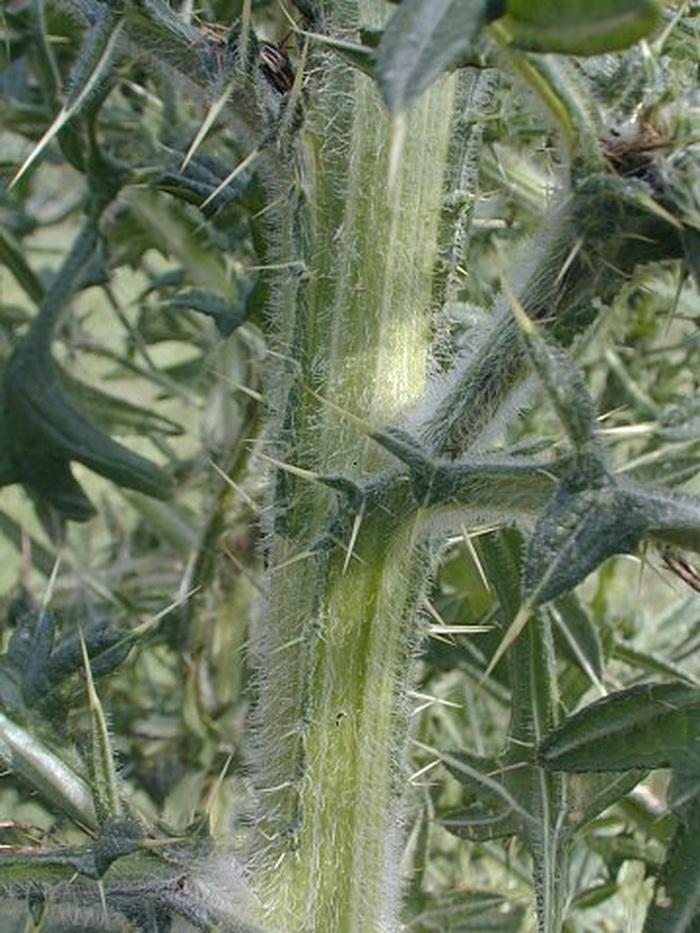
Comments: This is a very spiny thistle that can become quite tall. It is easily distinguished from many of the native thistles by the prickly bracts at the base of the flowerheads. These large bracts curl outward and narrow into sharp points, while the bracts of native thistles are appressed together and resemble green fish scales (fine spines are usually present on the outer bracts for some native species). The leaf undersides of the Bull Thistle are light green or whitish green, while the leaf undersides for some native thistles, such as Cirsium discolor (Pasture Thistle) and Cirsium altissimum (Tall Thistle), are powdery white in appearance. Other native thistles, however, don't have this latter characteristic. The Bull Thistle also has spines on its stems (from the decurrent extensions of the leaves), while the stems of native thistles are spineless.
The upper stems terminate in flowerheads of purplish pink to purple flowers. Each flowerhead is 1½–2" across and contains numerous disk florets, but no ray florets. Each disk floret is long and tubular, but becomes divided into 5 long thread-like lobes. This provides the flowerhead with a showy hair-like appearance. At the base of each flowerhead, are numerous green bracts that taper into stiff points that curl outward and are quite prickly. Among these bracts are cobwebby hairs in the background. The blooming period occurs from mid- to late summer and lasts about 3-4 weeks, after which the florets wither away. They are replaced by achenes with large tufts of white hair. These achenes are long, slender, and slightly ribbed. TheyDistribution Map are dispersed by the wind. The root system consists of a stout taproot that runs deep into the ground. This plants spreads by reseeding itself and occasionally forms colonies.
Cultivation: This thistle usually grows in full sun under moist to dry conditions. It prefers a fertile soil that consists of loam, clay loam, or that is slightly stony. Occasionally the foliage is affected by mildew during the summer or fall. Individual plants can produce a great abundance of seed, which have a high germination and survival rate. Thus, this plant can be quite aggressive. Because the seeds remain viable for only 1-2 years, one control strategy consists of destroying individual plants before they reach the flowering stage. It is possible for a plant to reestablish itself if a portion of the taproot remains in the ground.
Range & Habitat: The Bull Thistle is a common plant that occurs in most counties of Illinois. This thistle is adventive from Eurasia, and it has existed in the United States since the 19th century, if not earlier. Habitats include pastures, abandoned fields, fence rows, areas along roadsides and railroads, cut-over woods, and miscellaneous waste areas. This species prefers disturbed areas and it is not common in high quality natural areas.
Faunal Associations: The nectar and pollen of the flowers attract many kinds of long-tongued bees, including bumblebees, leaf-cutting bees (Megachile spp.), long-horned bees (Melissodes spp.), and cuckoo bees (Epeolus spp.). The flower nectar also attracts butterflies (especially swallowtails), skippers, and bee flies. Green metallic bees and other Halictid bees may collect pollen from the flowers, but they are non-pollinating. The caterpillars of the butterfly Vanessa cardui (Painted Lady) feed on the foliage. There are also many moth species with caterpillars that consume various parts of thistles (see Moth Table). The seeds are eaten by the American Goldfinch and the Clay-colored Sparrow. Goldfinches also use the tufts of hair as construction material for their little nests. Mammalian herbivores don't eat the Bull Thistle because it is heavily armed with spines. Even in overgrazed pastures where cattle and sheep have little to eat, the Bull Thistle is one of the few plants that is left alone.
Photographic Location: Along a fence row near the webmaster's apartment in Urbana, Illinois.

Comments: This is a very spiny thistle that can become quite tall. It is easily distinguished from many of the native thistles by the prickly bracts at the base of the flowerheads. These large bracts curl outward and narrow into sharp points, while the bracts of native thistles are appressed together and resemble green fish scales (fine spines are usually present on the outer bracts for some native species). The leaf undersides of the Bull Thistle are light green or whitish green, while the leaf undersides for some native thistles, such as Cirsium discolor (Pasture Thistle) and Cirsium altissimum (Tall Thistle), are powdery white in appearance. Other native thistles, however, don't have this latter characteristic. The Bull Thistle also has spines on its stems (from the decurrent extensions of the leaves), while the stems of native thistles are spineless.
0
0
文章
Miss Chen
2018年08月03日

Description: This annual or biennial plant is usually 1½–3' high, branching occasionally. The stems are variously colored, ranging from green to reddish brown. The lower stems can be quite hairy, while the upper stems are nearly hairless. The alternate leaves are up to 8" long and 2" across, becoming smaller as they ascend the stems. They are lanceolate, elliptic, or oblanceolate in overall shape, and either pinnatifid or dentate; the upper leaves have margins that are more smooth (entire). Each leaf narrows gradually to a petiole-like base, where it is either sessile or clasps the stem. There are usually conspicuous hairs along the central vein of the lower leaf surface.
The upper stems terminate in long inflorescences that are either spike-like, or they are open branching panicles. Widely spaced along the flowering stalks, there are sessile or nearly sessile flowerheads and short triangular bracts. These flowerheads are about 1-1½" across and they have 10-20 ray florets. The petaloid rays of these florets are light blue, fading to white; there are 5 tiny teeth at the tip of each petaloid ray. Toward the center of each flowerhead, there are several light blue stamens with blue anthers. The flowerheads bloom during the morning, and close-up later in the day, unless the skies are cloudy. The blooming period can occur from early summer to early fall, depending on the weather and the timing of disturbances (such as occasional mowing). The achenes are oblongoid and 5-ribbed; there is a pair of small scales at the apex of each achene. The root system consists of a stout taproot. Common Chicory spreads by reseeding itself.
Cultivation: Common Chicory appears to prefer full sun and a heavy soil that contains clay or gravel. This plant is typically found in locations that are mesic to dry, and it withstands drought rather well. Road salt and alkaline conditions are tolerated better than most plants. The foliage can appear rather battered-looking by the end of a hot dry summer.

Range & Habitat: The non-native Common Chicory has been reported in nearly all areas of Illinois, except a few counties in the NW and SE sections of the state (see Distribution Map). It is quite possible that Common Chicory occurs in those counties as well. This plant originated from Eurasia, and was present in Illinois by the late 19th century. It has been spreading steadily ever since and has become common, particularly in disturbed open areas. Typical habitats include pastures, abandoned fields, areas along roadsides and railroads, grassy areas that are not mowed regularly, undeveloped real estate lots, and other waste areas. Occasionally, Common Chicory colonizes disturbed areas of natural habitats (e.g., early stages of a prairie restoration), but it is not a serious invader of such natural areas in the long run.
Faunal Associations: The flowers attract short-tongued bees and probably other insects. Both nectar and pollen are available as floral rewards. The foliage of Common Chicory is eaten by Melanoplus bivittatus (Two-Striped Grasshopper), Melanoplus femurrubrum (Red-Legged Grasshopper), and probably other grasshoppers. The larvae of a lizard beetle, Acropteroxys gracilis, bore through the stems of this plant, while the caterpillars of the moth, Pyrrhia exprimens (Purple-Lined Sallow), feed on the the flowers, buds, and developing achenes. Because the foliage contains a bitter white latex, it is probably not preferred as a food source by mammalian herbivores, although cattle and sheep reportedly eat the basal leaves.
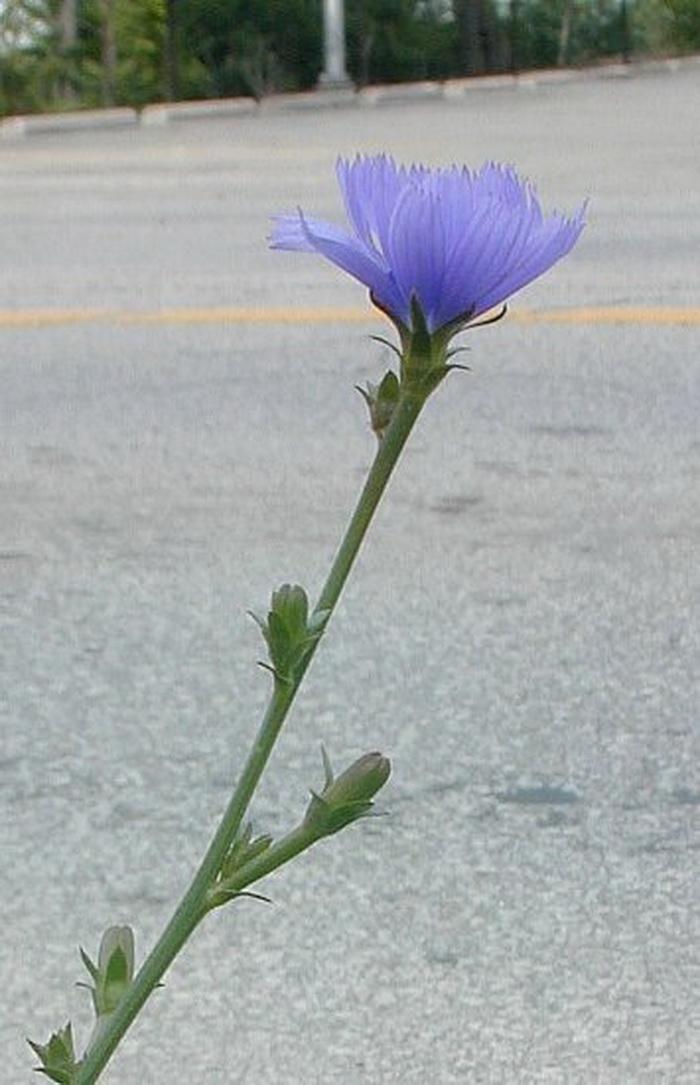
Photographic Location: Along a roadside in Urbana, Illinois.
Comments: The roots of Common Chicory have been roasted to create a coffee-substitute; they are also used as an ingredient in some herbal teas. The flowerheads are very beautiful, but short-lived. This species is easy to identify because of the appearance of these flowerheads – they are a lovely light blue, whereas similar plants in the Aster family usually have yellow flowerheads. However, some Lactuca spp. (Wild Lettuce) have light blue flowerheads that are smaller in size. These latter species produce achenes with tufts of hair, whereas the achenes of Common Chicory have only small scales.
The upper stems terminate in long inflorescences that are either spike-like, or they are open branching panicles. Widely spaced along the flowering stalks, there are sessile or nearly sessile flowerheads and short triangular bracts. These flowerheads are about 1-1½" across and they have 10-20 ray florets. The petaloid rays of these florets are light blue, fading to white; there are 5 tiny teeth at the tip of each petaloid ray. Toward the center of each flowerhead, there are several light blue stamens with blue anthers. The flowerheads bloom during the morning, and close-up later in the day, unless the skies are cloudy. The blooming period can occur from early summer to early fall, depending on the weather and the timing of disturbances (such as occasional mowing). The achenes are oblongoid and 5-ribbed; there is a pair of small scales at the apex of each achene. The root system consists of a stout taproot. Common Chicory spreads by reseeding itself.
Cultivation: Common Chicory appears to prefer full sun and a heavy soil that contains clay or gravel. This plant is typically found in locations that are mesic to dry, and it withstands drought rather well. Road salt and alkaline conditions are tolerated better than most plants. The foliage can appear rather battered-looking by the end of a hot dry summer.

Range & Habitat: The non-native Common Chicory has been reported in nearly all areas of Illinois, except a few counties in the NW and SE sections of the state (see Distribution Map). It is quite possible that Common Chicory occurs in those counties as well. This plant originated from Eurasia, and was present in Illinois by the late 19th century. It has been spreading steadily ever since and has become common, particularly in disturbed open areas. Typical habitats include pastures, abandoned fields, areas along roadsides and railroads, grassy areas that are not mowed regularly, undeveloped real estate lots, and other waste areas. Occasionally, Common Chicory colonizes disturbed areas of natural habitats (e.g., early stages of a prairie restoration), but it is not a serious invader of such natural areas in the long run.
Faunal Associations: The flowers attract short-tongued bees and probably other insects. Both nectar and pollen are available as floral rewards. The foliage of Common Chicory is eaten by Melanoplus bivittatus (Two-Striped Grasshopper), Melanoplus femurrubrum (Red-Legged Grasshopper), and probably other grasshoppers. The larvae of a lizard beetle, Acropteroxys gracilis, bore through the stems of this plant, while the caterpillars of the moth, Pyrrhia exprimens (Purple-Lined Sallow), feed on the the flowers, buds, and developing achenes. Because the foliage contains a bitter white latex, it is probably not preferred as a food source by mammalian herbivores, although cattle and sheep reportedly eat the basal leaves.

Photographic Location: Along a roadside in Urbana, Illinois.
Comments: The roots of Common Chicory have been roasted to create a coffee-substitute; they are also used as an ingredient in some herbal teas. The flowerheads are very beautiful, but short-lived. This species is easy to identify because of the appearance of these flowerheads – they are a lovely light blue, whereas similar plants in the Aster family usually have yellow flowerheads. However, some Lactuca spp. (Wild Lettuce) have light blue flowerheads that are smaller in size. These latter species produce achenes with tufts of hair, whereas the achenes of Common Chicory have only small scales.
0
0
文章
Miss Chen
2018年08月03日

Description: This herbaceous plant is a summer annual. A typical plant is about 6" tall and 12" across; it is abundantly branched at the base, and occasionally branched above. The stems are ascending to sprawling, more or less terete, pale reddish green to reddish purple, and glabrous. Sometimes the stems have vertical stripes that are green alternating with red. Alternate leaves occur along the entire length of each stem; they are ¾–2" long and 6-15 mm. across. The leaves are elliptic-oblong, elliptic, broadly elliptic, or lanceolate; they are shallowly pinnatifid, coarsely dentate, and/or sinuate along their margins. The leaf bases are wedge-shaped, while their tips and lobes (if any) are blunt or acute. The upper leaf surface is medium green or bluish green and glabrous, while the lower leaf surface is white-mealy (farinose). The petioles are up to ½" long, light green to yellowish red, and glabrous. The stems eventually terminate in either spikes or panicles of interrupted clusters of flowers; there are also axillary spikes of flowers that develop from the upper leaves. Individual floral spikes are up to 2" long; there are several small flowers per cluster. Some flowers may have pedicels up to 0.5 mm. long. Each mature flower is about 2 mm. across, consisting of 3-5 greenish sepals, 3-5 stamens, and a pistil with a pair of styles; there are no petals. The sepals are lanceolate to ovate, bluntly tipped, and glabrous; they are either weakly keeled or flat. The stamens are exserted with yellow anthers. The rachises of floral spikes are glabrous.
The blooming period occurs from early summer to early autumn. However, individual plants remain in bloom for about 1 month; only a few flowers bloom at the same time. The flowers are cross-pollinated by the wind. Afterwards, the ovaries of the flowers develop into seeds (a single seed per flower); the orientation of these seeds may be vertical or horizontal. The persistent sepals cover only the edges of these seeds. Individual seeds are 0.5–1 mm. across, globular-flattened in shape, and dark brown to dark reddish brown. Thin membranes cover the seeds; they are easily removed. The root system consists of a shallow taproot with secondary roots that are fibrous. This plant reproduces by reseeding itself.
Cultivation: The preference is full to partial sun, more or less mesic conditions, and soil containing some sand or loose loam. The size of individual plants is variable, depending on soil fertility and moisture conditions. Once the seeds have germinated in late spring, growth and development is rapid.
Range & Habitat: The adventive Oak-leaved Goosefoot is occasional in NE Illinois and uncommon elsewhere in the state (see Distribution Map). This plant is native to Eurasia. Habitats include cropland, gardens, construction sites, areas along railroads, roadsides, barnyards, and waste areas. Habitats with a history of disturbance are preferred, especially when this exposes the topsoil.

Faunal Associations: Various insects feed on the foliage, roots, and other parts of goosefoot species (Chenopodium spp.). These insect feeders include the Three-spotted Flea Beetle (Disonycha triangularis), larvae of the Spinach Leafminer Fly (Pegomya hyoscyami), the Chenopodium Aphid (Hayhurstia atriplicis) and Sugar Beet Root Aphid (Pemphigus betae), the Chenopodium Leafhopper (Norvellina chenopodii), and the larvae of such moths as the Flamboyant Twirler Moth (Chrysoesthia lingulacella), Hollow-spotted Blepharomastix (Blepharomastix ranalis), Chenopodium Scythris Moth (Scythris limbella), Eight-Spot (Amyna octo), Ragweed Borer Moth (Epiblema strenuana), and Morning Glory Plume Moth (Emmelina monodactyla). In addition, the caterpillars of two skippers, the Common Sootywing (Pholisora catullus) and Hayhurst's Scallopwing (Staphylus hayhurstii), also feed on these plants. Among vertebrate animals, upland gamebirds and many songbirds, especially sparrows, eat the seeds of goosefoot species (Martin et al., 1951/1961). The Bird Table provides a list of these species. Some small rodents also eat the seeds, including the Thirteen-lined Ground Squirrel, Prairie Deer Mouse, and White-footed Mouse (Whitaker, 1966). White-tailed Deer browse on the foliage and seedheads of goosefoot species, including Oak-leaved Goosefoot. The seeds of these plants are able to pass through the digestive tract of this animal and remain viable. In this manner, the seeds are dispersed across considerable distances (Myers et al., 2004).

Photographic Location: Along a sidewalk in Urbana, Illinois, where some construction and landscaping activity occurred.
Comments: Oak-leaved Goosefoot (Chenopodium glaucum) can be distinguished from most goosefoot species (Chenopodium spp.) by the shape of its leaves. In addition, the undersides of its leaves are white-mealy, while the rest of the plant is glabrous or nearly so. The flowers of Oak-leaved Goosefoot are also glabrous, and their sepals cover only the margins of the developing ovaries or seeds. Other goosefoot species usually have differently shaped leaves, their flowers are more or less white-mealy, and their sepals cover most of the developing ovaries or seeds. Like other weedy goosefoot species, Oak-leaved Goosefoot has a preference for disturbed habitats with exposed topsoil. It is less erect than most of them, having a tendency to remain relatively low and sprawl across the ground. There is a variety of Oak-leaved Goosefoot, Chenopodium glaucum salinum, that is native to the western United States. It tends to have bluish foliage, while the lobes, teeth, and tips of its leaves are usually more narrow and pointed. There are no records of this variety occurring in Illinois at the present time.
The blooming period occurs from early summer to early autumn. However, individual plants remain in bloom for about 1 month; only a few flowers bloom at the same time. The flowers are cross-pollinated by the wind. Afterwards, the ovaries of the flowers develop into seeds (a single seed per flower); the orientation of these seeds may be vertical or horizontal. The persistent sepals cover only the edges of these seeds. Individual seeds are 0.5–1 mm. across, globular-flattened in shape, and dark brown to dark reddish brown. Thin membranes cover the seeds; they are easily removed. The root system consists of a shallow taproot with secondary roots that are fibrous. This plant reproduces by reseeding itself.
Cultivation: The preference is full to partial sun, more or less mesic conditions, and soil containing some sand or loose loam. The size of individual plants is variable, depending on soil fertility and moisture conditions. Once the seeds have germinated in late spring, growth and development is rapid.
Range & Habitat: The adventive Oak-leaved Goosefoot is occasional in NE Illinois and uncommon elsewhere in the state (see Distribution Map). This plant is native to Eurasia. Habitats include cropland, gardens, construction sites, areas along railroads, roadsides, barnyards, and waste areas. Habitats with a history of disturbance are preferred, especially when this exposes the topsoil.

Faunal Associations: Various insects feed on the foliage, roots, and other parts of goosefoot species (Chenopodium spp.). These insect feeders include the Three-spotted Flea Beetle (Disonycha triangularis), larvae of the Spinach Leafminer Fly (Pegomya hyoscyami), the Chenopodium Aphid (Hayhurstia atriplicis) and Sugar Beet Root Aphid (Pemphigus betae), the Chenopodium Leafhopper (Norvellina chenopodii), and the larvae of such moths as the Flamboyant Twirler Moth (Chrysoesthia lingulacella), Hollow-spotted Blepharomastix (Blepharomastix ranalis), Chenopodium Scythris Moth (Scythris limbella), Eight-Spot (Amyna octo), Ragweed Borer Moth (Epiblema strenuana), and Morning Glory Plume Moth (Emmelina monodactyla). In addition, the caterpillars of two skippers, the Common Sootywing (Pholisora catullus) and Hayhurst's Scallopwing (Staphylus hayhurstii), also feed on these plants. Among vertebrate animals, upland gamebirds and many songbirds, especially sparrows, eat the seeds of goosefoot species (Martin et al., 1951/1961). The Bird Table provides a list of these species. Some small rodents also eat the seeds, including the Thirteen-lined Ground Squirrel, Prairie Deer Mouse, and White-footed Mouse (Whitaker, 1966). White-tailed Deer browse on the foliage and seedheads of goosefoot species, including Oak-leaved Goosefoot. The seeds of these plants are able to pass through the digestive tract of this animal and remain viable. In this manner, the seeds are dispersed across considerable distances (Myers et al., 2004).

Photographic Location: Along a sidewalk in Urbana, Illinois, where some construction and landscaping activity occurred.
Comments: Oak-leaved Goosefoot (Chenopodium glaucum) can be distinguished from most goosefoot species (Chenopodium spp.) by the shape of its leaves. In addition, the undersides of its leaves are white-mealy, while the rest of the plant is glabrous or nearly so. The flowers of Oak-leaved Goosefoot are also glabrous, and their sepals cover only the margins of the developing ovaries or seeds. Other goosefoot species usually have differently shaped leaves, their flowers are more or less white-mealy, and their sepals cover most of the developing ovaries or seeds. Like other weedy goosefoot species, Oak-leaved Goosefoot has a preference for disturbed habitats with exposed topsoil. It is less erect than most of them, having a tendency to remain relatively low and sprawl across the ground. There is a variety of Oak-leaved Goosefoot, Chenopodium glaucum salinum, that is native to the western United States. It tends to have bluish foliage, while the lobes, teeth, and tips of its leaves are usually more narrow and pointed. There are no records of this variety occurring in Illinois at the present time.
0
0
成长记
Shanee
2018年08月03日

I now added "Snake Plant" in my "garden"
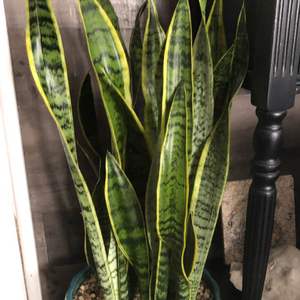

0
0
Shanee:What are u referring to? The soil? Light? Location?
libbybuie912@yahoo.com:That’s beautiful. How do you manage to keep this?
文章
Miss Chen
2018年08月02日

Purple sage (Salvia leucophylla) is an evergreen plant that typically grows 3 to 6 feet tall, though some individual specimens have been known to reach 12 feet tall and 12 feet wide. Purple sage shrubs have aromatic gray-green vegetation, an attractive, airy form and fragrant lavender-pink blooms. They thrive in full sun but need no water once established, which makes them ideal for drought-tolerant landscaping. Plants also tolerate freezing temperatures. This distant relative of culinary sage is best pruned minimally, to support general plant health and encourage optimal flowering in the landscape.

Step 1
Prune purple sage only with a purpose, because any unnecessary trimming will only diminish the amount of attractive, fragrant flowers.
Step 2
Make major pruning cuts only when purple sage is dormant, near the end of the winter when the coldest temperatures have passed.
Step 3
Assess the shrub and its condition thoroughly before making any additional pruning cuts. First cut off dead, diseased or otherwise damaged branches and stems.
Step 4
Stand back to study the plant's symmetry and general proportions, walking all the way around if necessary. Make your next cuts to enhance overall balance.
Step 5
Trim lightly to remove dead branches and stems -- or to make corrective cuts you may have missed earlier -- at any time during the year.

Step 6
Deadhead spent purple sage flowers for a neater look if desired, but this isn't absolutely necessary because dried flowers look fine too -- and leaving them gives seeds a chance to develop and disperse.

Step 1
Prune purple sage only with a purpose, because any unnecessary trimming will only diminish the amount of attractive, fragrant flowers.
Step 2
Make major pruning cuts only when purple sage is dormant, near the end of the winter when the coldest temperatures have passed.
Step 3
Assess the shrub and its condition thoroughly before making any additional pruning cuts. First cut off dead, diseased or otherwise damaged branches and stems.
Step 4
Stand back to study the plant's symmetry and general proportions, walking all the way around if necessary. Make your next cuts to enhance overall balance.
Step 5
Trim lightly to remove dead branches and stems -- or to make corrective cuts you may have missed earlier -- at any time during the year.

Step 6
Deadhead spent purple sage flowers for a neater look if desired, but this isn't absolutely necessary because dried flowers look fine too -- and leaving them gives seeds a chance to develop and disperse.
0
0



